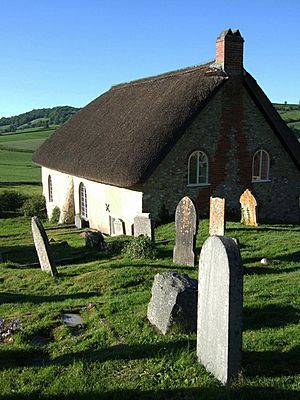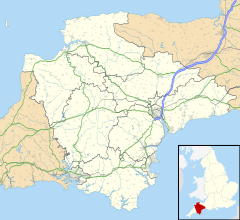Loughwood Meeting House facts for kids
Quick facts for kids Loughwood Meeting House |
|
|---|---|

Loughwood Meeting House
|
|
| Religion | |
| Affiliation | Baptist |
| Location | |
| Location | Dalwood, Devon |
| Architecture | |
| Architectural type | Chapel |
| Groundbreaking | 1653 |
Loughwood Meeting House is a very old and special Baptist church building, located about 1 mile south of the village of Dalwood in Devon, England. It's called a "meeting house" because it was a place where people could meet to worship. There has been a building for worship on this spot since 1653. The building you see today might be from the late 1600s or early 1700s.
This meeting house is one of the oldest Baptist worship places still standing. Since 1969, a group called the National Trust has taken care of it. It's also recognized as a Grade II* listed building by English Heritage, which means it's a very important historical site.
Why Loughwood Meeting House is Special
This meeting house was started by Baptist people from Kilmington, Devon, a village nearby. Long ago, before a law called the Act of Toleration 1689 was passed, it was against the law for some religious groups, like Baptists, to meet and worship freely. This made Loughwood Meeting House a perfect secret spot.
It was built into a hillside, hidden by trees, and you could only reach it by small, narrow paths. From the outside, it looked like a simple farm cottage, so it didn't draw much attention. Only the gravestones around it hinted that it was a special place. Even today, the church in Kilmington still uses Loughwood Meeting House for worship twice a year.
What the Building Looks Like
The meeting house is made of stone and has a thatched roof, which means the roof is made of straw or reeds. The inside of the building was set up in the mid-1700s to early 1800s.
Inside, there's a tall pulpit at the front where the preacher would stand. On one side, there are "box pews," which are like small enclosed seating areas. On the other side, some pews are square, and others run along the wall. Musicians used to sit in the front pews of the gallery, which is a raised area, and they had special stands for their music. There was even a small notch in the floor for the foot of a bass viol, a type of musical instrument.
At the back of the meeting house, there are two small rooms. These were used for cooking meals when the church members met for the whole day on Sundays. Outside, there's a graveyard, with the first burial happening in 1659. In one corner of the graveyard, there's a stable where people could keep their horses if they traveled a long way to attend church. There was also a special pool for baptisms.
Who Were the Early Members?
The earliest written records of the church go back to 1653, but the church itself was probably around even before that. Some of the first members were John Vernon and William Allen. They had been soldiers in the English Civil War in 1645, fighting with General Thomas Fairfax's army.
Other early members were Huguenots, who were Protestants who had to escape from France. Because their names were hard to say, people often just called them "French." This "French" surname is still common among church members and in the area today.


